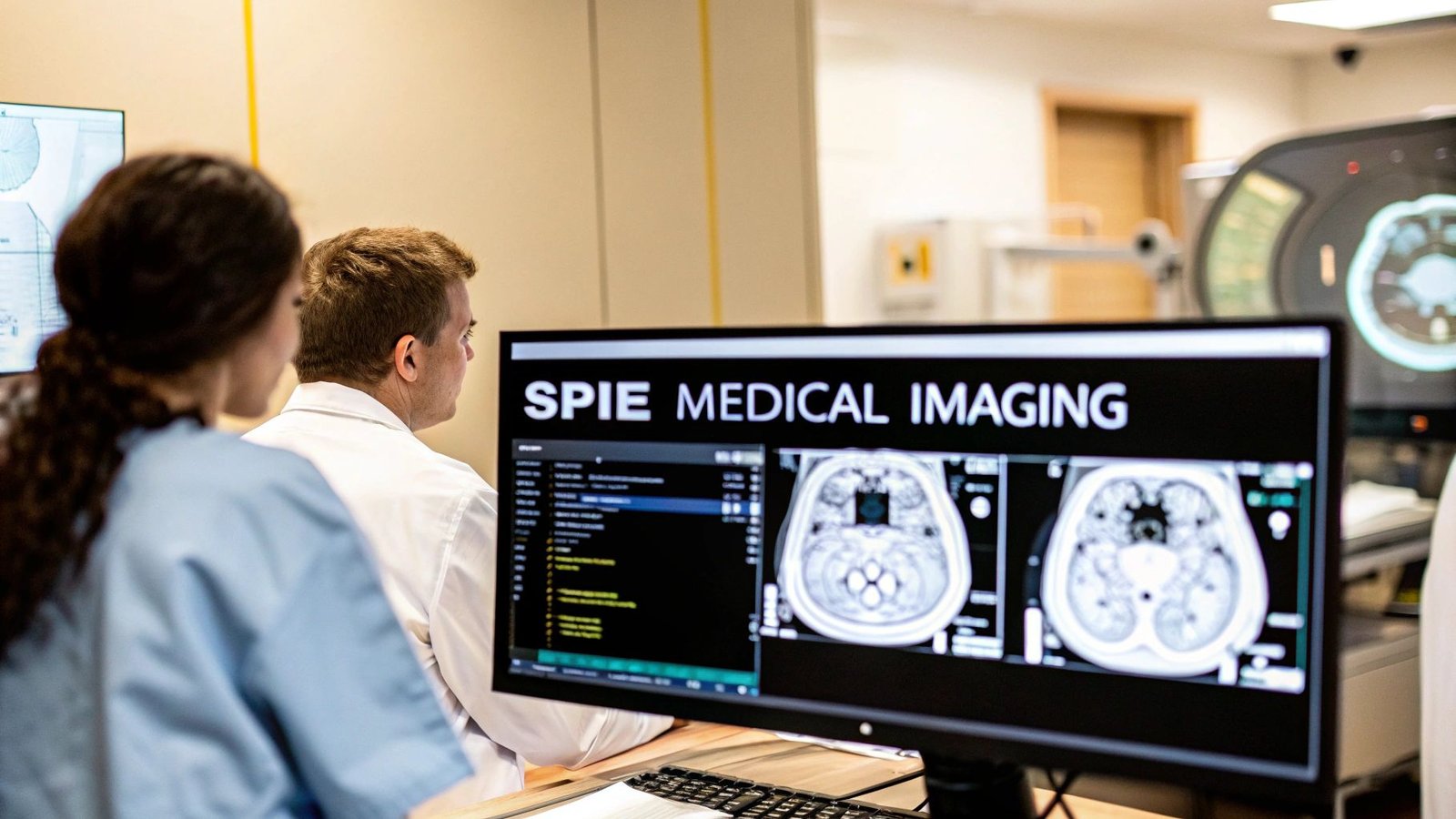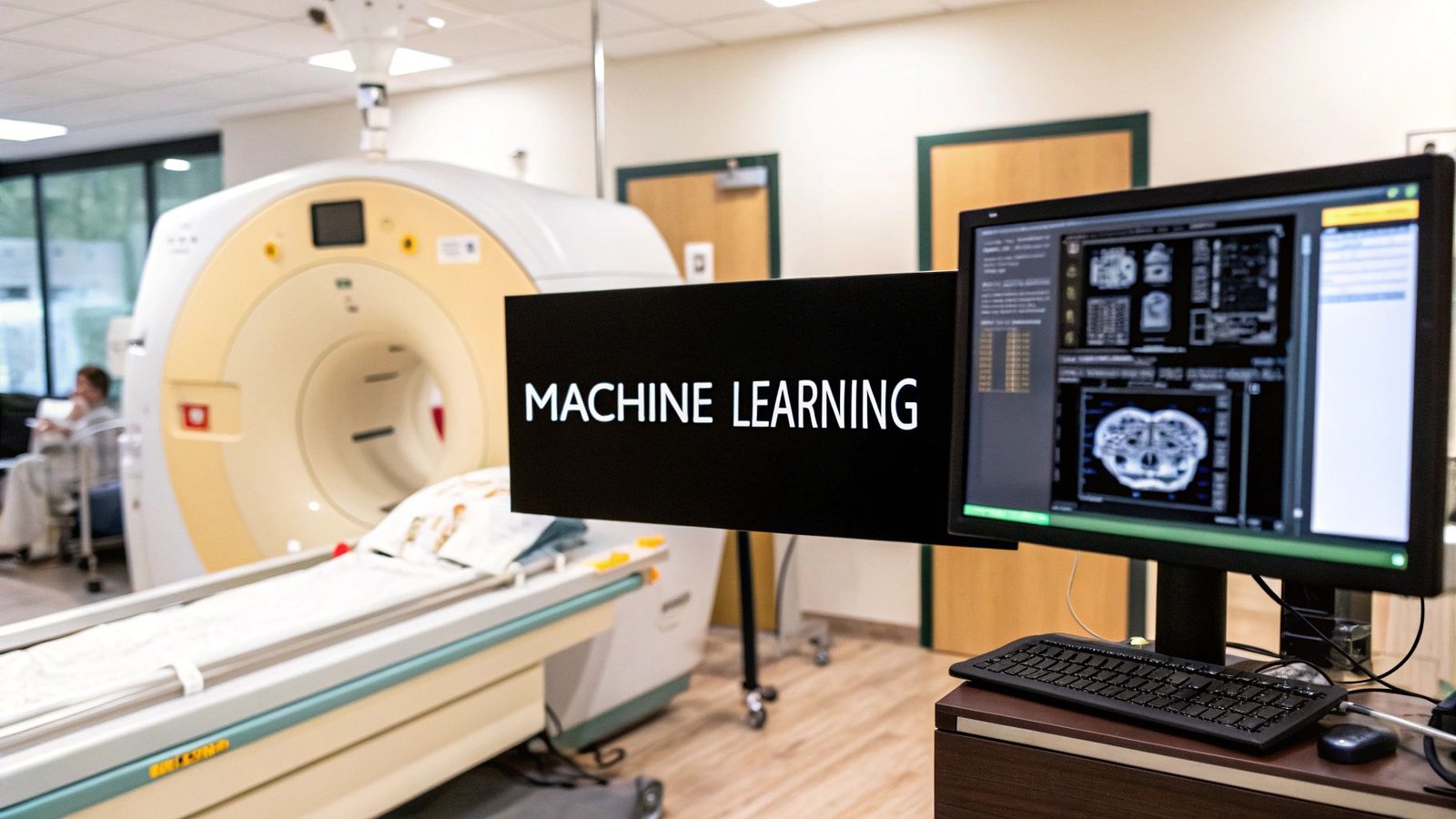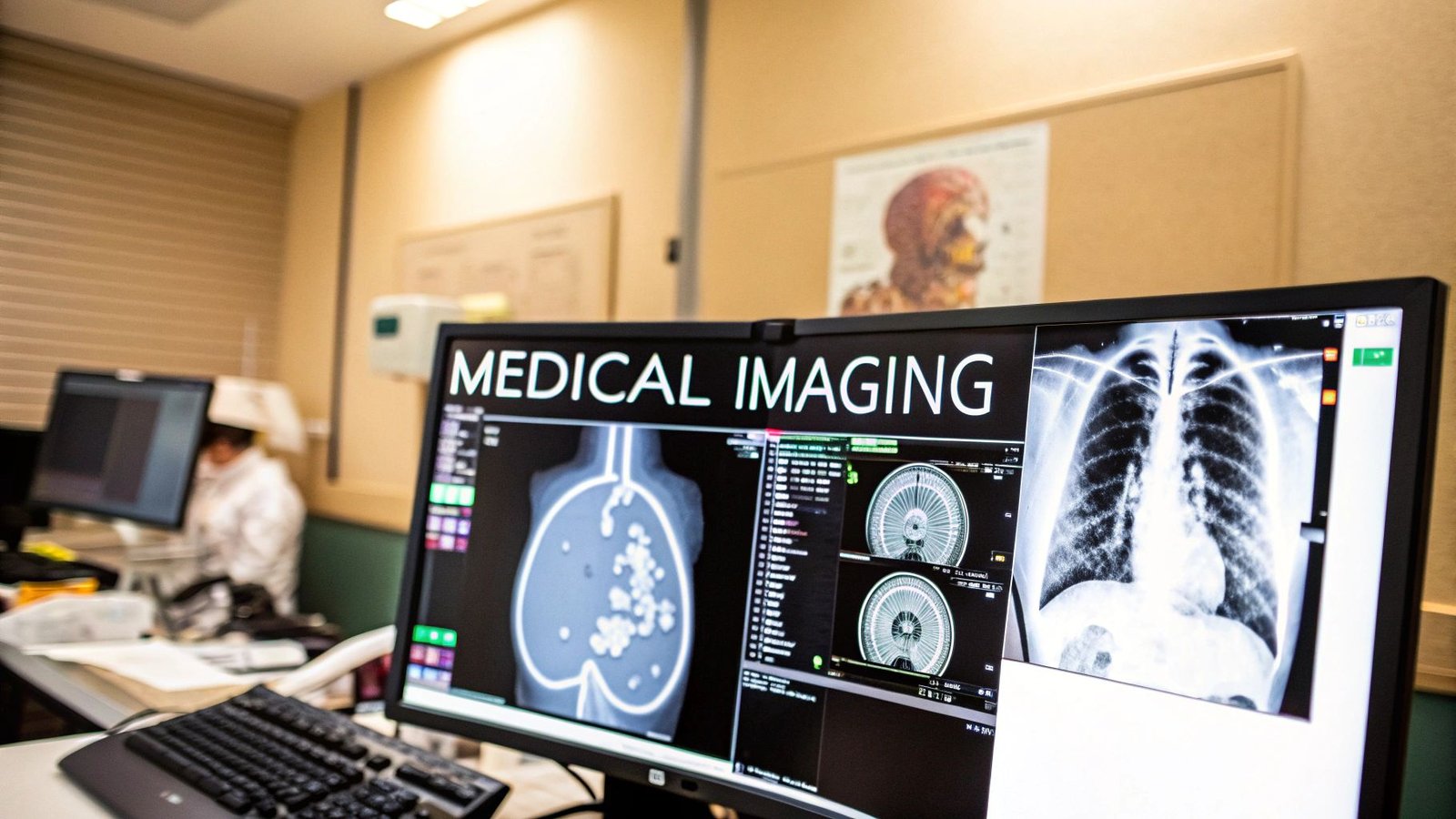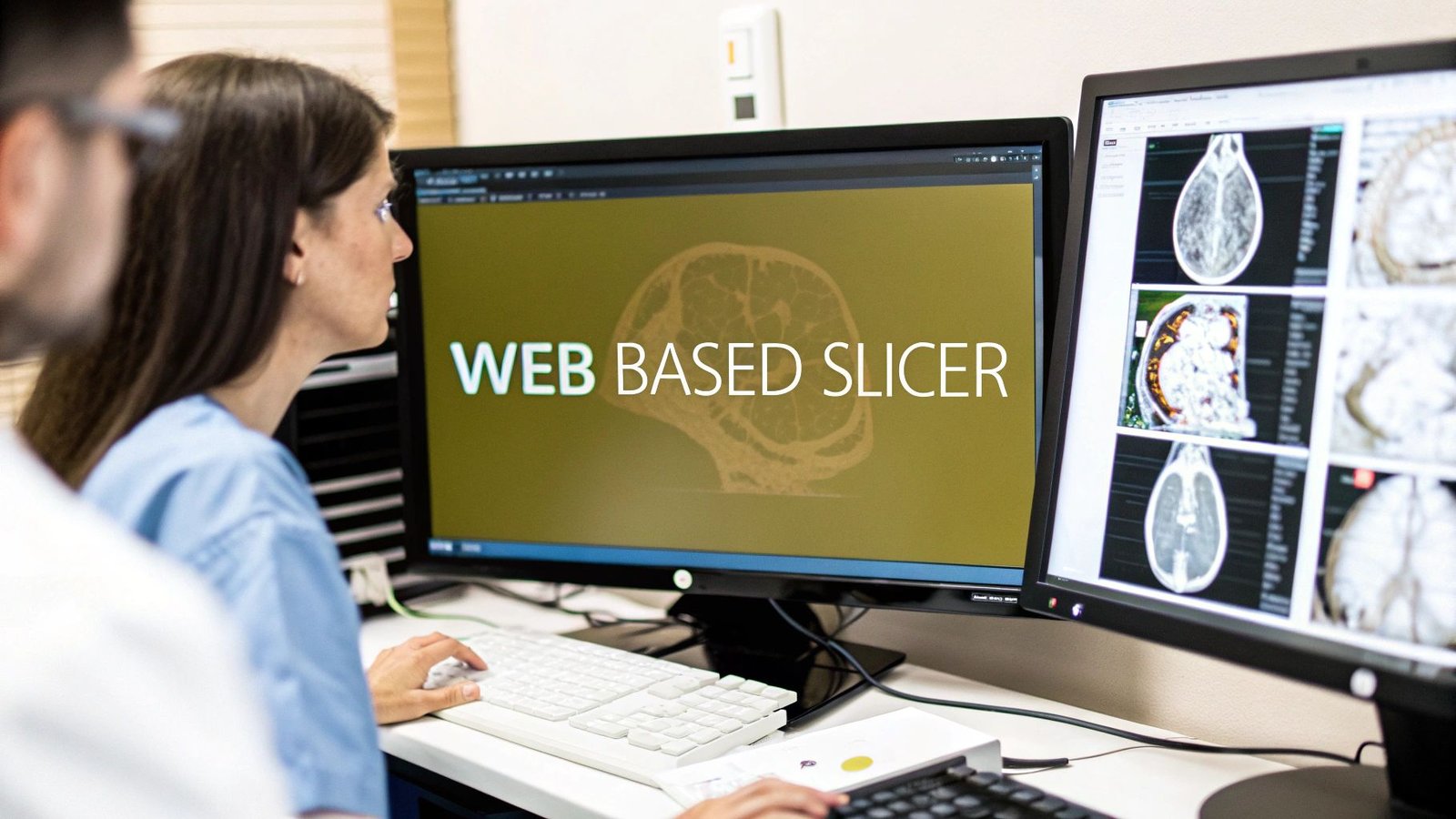Picture this: a single place where the most brilliant minds in medicine, physics, and computer science come together, all with one goal—to revolutionize how we see inside the human body. This isn't science fiction; it's the SPIE Medical Imaging symposium.
What Is the SPIE Medical Imaging Symposium

The SPIE Medical Imaging symposium is so much more than a standard conference. It's an active, buzzing ecosystem where breakthroughs in physics, image processing, and AI aren’t just discussed—they’re born.
Think of it as the command center for the future of diagnostics. Every year, this event draws thousands of passionate individuals from over 50 countries, creating an incredible melting pot of ideas, collaboration, and pure discovery.
To give you a clearer picture, here's a quick overview of what makes this symposium a landmark event.
SPIE Medical Imaging At a Glance
| Aspect | Description |
|---|---|
| Core Mission | To accelerate the translation of research in medical imaging into tangible clinical applications that improve patient care. |
| Key Participants | A diverse mix of physicists, engineers, computer scientists, clinicians, radiologists, and industry pioneers. |
| Annual Scale | Features over 1,000 presentations, including inspiring keynotes, in-depth technical papers, and interactive poster sessions. |
| Global Reach | Attracts thousands of professionals from more than 50 countries, making it a truly international hub for innovation. |
| Primary Focus Areas | Covers the full spectrum: image perception, physics of imaging, image processing, digital pathology, and the growing role of AI. |
This table just scratches the surface, but it shows how the event brings together every critical piece of the medical imaging puzzle.
A Global Hub for Innovation
At its heart, the symposium is all about connecting the dots. It’s where researchers, clinicians, and industry leaders unite to push the boundaries of what’s possible. In recent years, we've seen an explosion of work centered on AI and machine learning, which reflects a massive shift in how we approach diagnostics.
This push toward smarter technology is critical. Modern scanners produce an incredible volume of data, and making sense of it all is a huge challenge. It’s why understanding tools like a PACS system has become so fundamental for anyone in the field.
The real magic of the SPIE Medical Imaging event is its power to shrink the gap between a brilliant idea in a lab and a life-saving tool in a hospital. It’s where theory gets real.
Fostering Collaboration and Progress
The entire event is designed to spark conversation and collaboration. It’s where a physicist perfecting a new sensor can grab a coffee with a radiologist who can immediately see its potential for early cancer detection. That’s the kind of interdisciplinary energy that moves medicine forward.
This spirit is what drives us at PYCAD. We live for taking these advanced concepts and building them into practical tools for the clinic. We at PYCAD, build custom web DICOM viewers and integrate them into medical imaging web platforms. We’re passionate about ensuring the incredible innovations showcased at SPIE make their way into the hands of healthcare professionals who can use them to save lives. You can see our work on our portfolio page.
Diving Into the Core Research Tracks
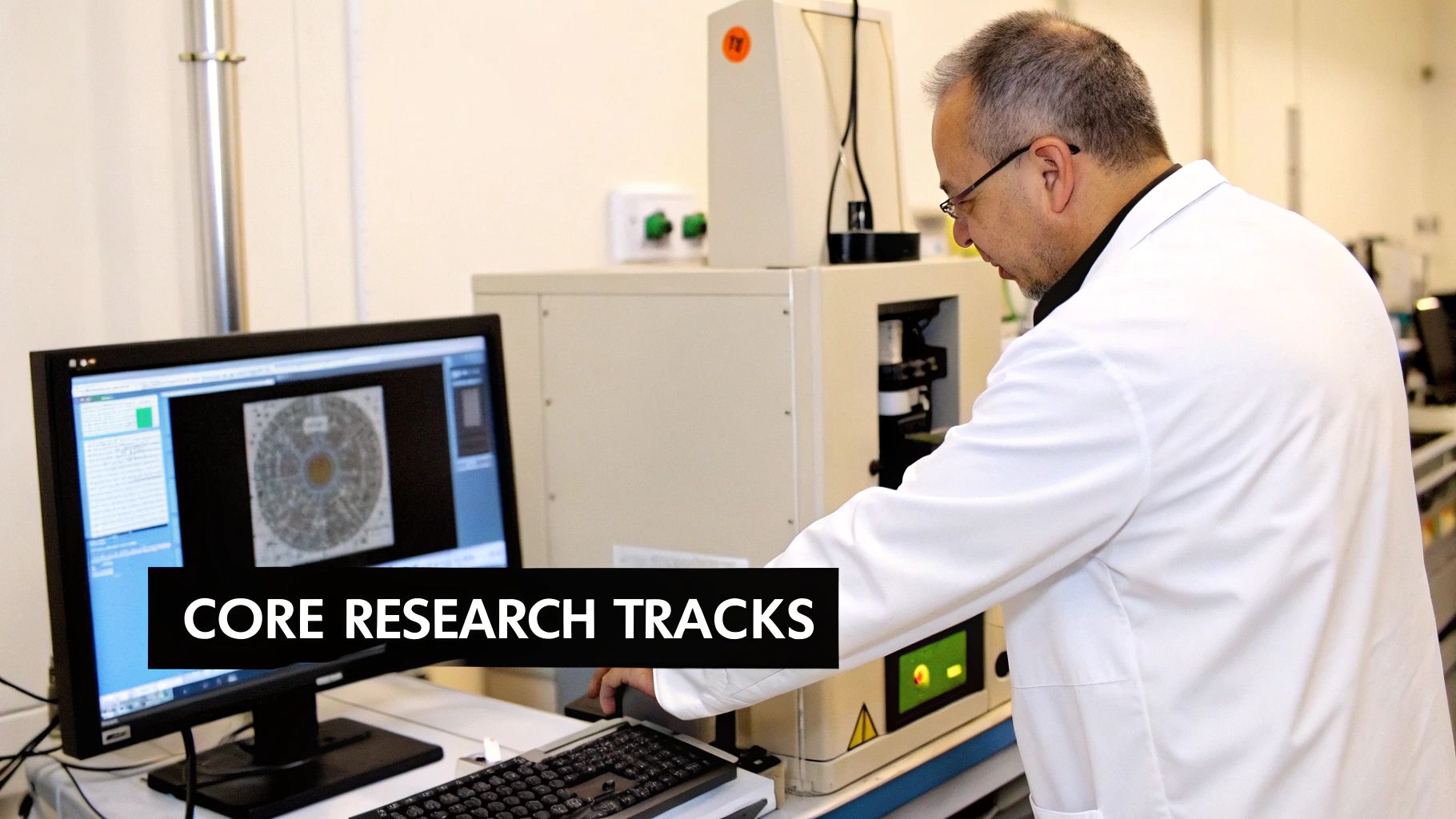
To really get a feel for the incredible energy at a medical imaging SPIE event, you have to look at its core components: the research tracks. These are the pillars where every breakthrough begins. Each one represents a vital step on the journey from a simple physical scan to a life-changing clinical diagnosis.
But don't think of these tracks as separate conversations happening in different rooms. They're deeply connected, like different sections of an orchestra playing in harmony. The symposium is one of the few places where experts from these distinct fields can come together, share their latest findings, and spark new ideas. Progress in one area immediately fuels innovation in the next. It’s this collaborative spirit that makes the event such a powerful force for change.
The Physics of Medical Imaging
This is where it all starts—the engine room of medical diagnostics. Here, physicists and engineers are obsessed with the fundamental hardware that captures images from inside the human body. Their entire focus is on bending the laws of physics to their will, creating scanners that are faster, safer, and more precise than ever before.
What does that look like in practice? It might be developing new sensor materials for CT scanners that dramatically lower radiation exposure. Or it could be designing brand-new ultrasound transducers that produce images with astonishing resolution. Every single improvement at this physical level creates a cleaner, richer source of data for everyone else down the line. It's the bedrock upon which everything is built.
Image Processing and Refinement
Once a scanner captures an image, the raw data is rarely perfect. It's often noisy, blurry, or just not clear enough for a confident diagnosis. This is where the Image Processing track comes in. Think of it as the darkroom or the digital artist’s studio.
Computer scientists and engineers in this track develop brilliant algorithms to clean up, sharpen, and perfect those raw images. They're on a mission to turn messy data into crystal-clear visuals that tell a story. This involves a few key steps:
- Noise Reduction: Filtering out the random electronic static that can hide tiny, critical details.
- Edge Enhancement: Making the boundaries between different tissues sharper and more defined.
- Image Reconstruction: Taking a series of 2D slices and building them into a detailed 3D model that a doctor can explore from any angle.
Here at PYCAD, we live and breathe this stage. A flawlessly processed image can make all the difference, which is why we build custom web DICOM viewers and integrate them into medical imaging web platforms. Our goal is to make sure clinicians have the clearest possible view. You can see what we mean on our portfolio page.
Computer-Aided Diagnosis
The final track is like giving the clinician an intelligent co-pilot. Once an image is captured and refined, Computer-Aided Diagnosis (CAD) uses smart algorithms to help interpret what’s being seen. This is where the AI revolution in medicine is truly taking off.
These algorithms are trained to spot patterns—often so subtle they’re invisible to the human eye—that might signal the very early stages of a disease. They aren’t there to replace the radiologist, but to act as a powerful second set of eyes, flagging areas of concern and giving doctors an extra layer of confidence in their diagnoses.
The AI Revolution in Diagnostic Imaging

If there's one force completely reshaping medical imaging today, it's artificial intelligence. At every medical imaging SPIE symposium, AI isn't just a buzzword; it's the electrifying pulse of the entire event. The screenshot above from the official conference page gives you a sense of this forward-thinking community, a gathering dedicated to exploring what’s next. This is where AI stops being theoretical and becomes a tangible, powerful tool in the diagnostic process.
The stories you hear are genuinely inspiring. Researchers present findings on AI models that spot early-stage cancers with a precision that rivals, and sometimes even surpasses, seasoned experts. You'll see smart algorithms designed to slash patient radiation exposure during CT scans, all while keeping the image crystal clear.
This isn’t about replacing radiologists. It’s about giving them superpowers. AI is brilliant at handling the repetitive, time-consuming tasks, freeing up clinicians to focus their expertise on the toughest diagnoses, patient care, and treatment strategy.
Making AI a Practical Tool for Clinicians
This is where the magic happens—where groundbreaking research meets the real world. The global market for AI in medical imaging is expected to reach USD 1.63 billion in 2025 and is projected to expand at an incredible CAGR of 34.6% through 2032. This isn't just hype; this growth is fueled by AI's proven ability to sharpen diagnostic accuracy, streamline workflows, and cut down on expensive rescans.
But for these powerful tools to be useful, they have to fit seamlessly into a clinician's daily routine. That’s where we at PYCAD come in. We focus on building the practical infrastructure that puts AI to work. At our core, we build custom web DICOM viewers and integrate them into medical imaging web platforms, creating an intuitive space where AI insights are right at the clinician's fingertips. See how we've done this for others on our portfolio page.
If you're curious about the algorithms behind these changes, our article on https://pycad.co/machine-learning-medical-imaging/ provides a much deeper look.
The Technical Heart of the AI Boom
The algorithms showcased at SPIE are breathtakingly complex, capable of sifting through millions of data points in a single medical image. To really appreciate what’s happening under the hood, it’s helpful to understand how AI analyzes data at a fundamental level.
The ultimate goal is to create a synergy between human expertise and machine intelligence, where each elevates the other to achieve better patient outcomes.
This very synergy is what turns a promising research paper into a life-saving clinical tool. By developing accessible and powerful platforms, we help ensure that the brilliant innovations from the medical imaging SPIE community get into the hands of the people who need them most.
The Big Picture: Where SPIE Fits in the Global Medical Imaging Market
The groundbreaking ideas presented at a medical imaging SPIE event aren’t just academic exercises. They are the sparks that ignite a massive, constantly growing global industry. Every single research paper and technical talk represents a potential answer to a real-world healthcare problem, bridging the gap between brilliant minds and the economic realities of patient care.
This connection isn't abstract—it's incredibly direct. Think about major global shifts, like our aging population and the unfortunate rise of chronic diseases. These trends create an urgent, powerful demand for the very diagnostic tools being refined and perfected at SPIE. An imaging technique discussed in a session today could very well become a standard procedure in hospitals tomorrow, changing millions of lives and steering billions in investment.
The Financial Pulse of Diagnostic Technology
The numbers driving this industry are truly mind-boggling. The global medical imaging market hit a value of around USD 43.9 billion in 2024, and it’s not slowing down. Forecasts predict it will soar to USD 75.8 billion by 2034, growing at a steady clip of 5.7% each year. This isn't just growth for growth's sake; it's a direct response to the increasing need for better ways to diagnose and monitor conditions like cancer and heart disease. For a deeper dive, check out this detailed medical imaging market report.
This economic engine is precisely why SPIE is so much more than a conference. It’s a powerful bellwether for where healthcare investment is heading and a preview of the market's future direction. It's where the seeds of the next generation of medical devices are planted.
You can think of SPIE as a sneak peek into the future of clinical practice. It's where we see the technologies that will soon set new diagnostic standards and attract billions in funding to bring them to life.
This vibrant world is home to a huge range of players, from industry giants to agile startups pushing the envelope. If you're curious about who the key innovators are, we put together a guide on the top medical AI companies that are really making waves.
Here at PYCAD, we live at this very intersection of innovation and real-world application. Our whole mission is to take the incredible concepts born at events like SPIE and turn them into practical, functional tools. We build custom web DICOM viewers and integrate them into medical imaging web platforms, making sure these powerful technologies are not just ideas, but accessible and effective tools in the hands of clinicians. Our portfolio shows exactly how we make it happen.
How to Make the Most of Your Time at SPIE
Showing up at the SPIE Medical Imaging symposium is one thing, but truly making it count is another. It's about actively steering your career and research forward. Whether you're a first-timer soaking it all in or a seasoned pro hunting for the next big collaboration, this is where you can feel the pulse of innovation. The trick is to walk in with a clear mission.
For researchers and academics, the goal is to make your work stick. This isn't just a data dump; it's about telling a compelling story. Frame your research around a problem people actually care about, and show them how your work offers a real path forward. Get into the conversation, ask questions during other talks, and be ready to stand behind your ideas. Honestly, the connections you spark during a Q&A can be more valuable than the presentation itself.
If you're representing a company in the industry, think of the exhibition hall as your stage. It’s your chance to show everyone not just what your technology can do, but why it genuinely matters to patients and clinicians.
Maximizing Your SPIE Experience
To really get the most out of the week, you need a game plan that matches what you're trying to achieve. Everyone's goals are a bit different, so it helps to think about where your energy is best spent.
Here's a quick breakdown to help you focus your efforts:
| Participant Type | Key Objective | Actionable Strategy |
|---|---|---|
| Researcher | Share findings and spark new collaborations. | Practice telling the story behind your data. Go meet experts in fields next to yours—their work might be the missing piece to your puzzle. |
| Attendee | Absorb knowledge and build professional connections. | Map out your must-see sessions ahead of time, but leave a little wiggle room for those unexpected, interesting conversations. Make it a goal to meet three new people at every networking event. |
| Company/Exhibitor | Generate leads and showcase innovation. | Create a hands-on demo that solves a real problem. Connect what you're showing to the pain points being discussed in the technical sessions. |
Thinking strategically like this helps turn a potentially overwhelming week into a series of focused, productive opportunities.
Building Connections That Last
Beyond the formal talks and shiny exhibits, the real magic of SPIE happens in the moments in between. The coffee breaks, the casual lunches, the evening socials—that's where ideas cross-pollinate and partnerships begin. Don't be afraid to step out of your comfort zone and introduce yourself to the people whose work you admire.
Remember that every single person at SPIE is there because they share a deep passion for pushing healthcare forward. That shared purpose is the perfect icebreaker, transforming a room full of strangers into a genuine community.
This is exactly the kind of energy that fuels our work at PYCAD. We live for these connections and the ideas that come from them. At PYCAD, we build custom web DICOM viewers and integrate them into medical imaging web platforms, turning the very concepts debated at SPIE into powerful, real-world tools.
You can see how we bring these ideas to life by checking out our portfolio page. Your next conversation at SPIE could be the one that starts something incredible.
Bringing Innovation to Your Clinical Workflow
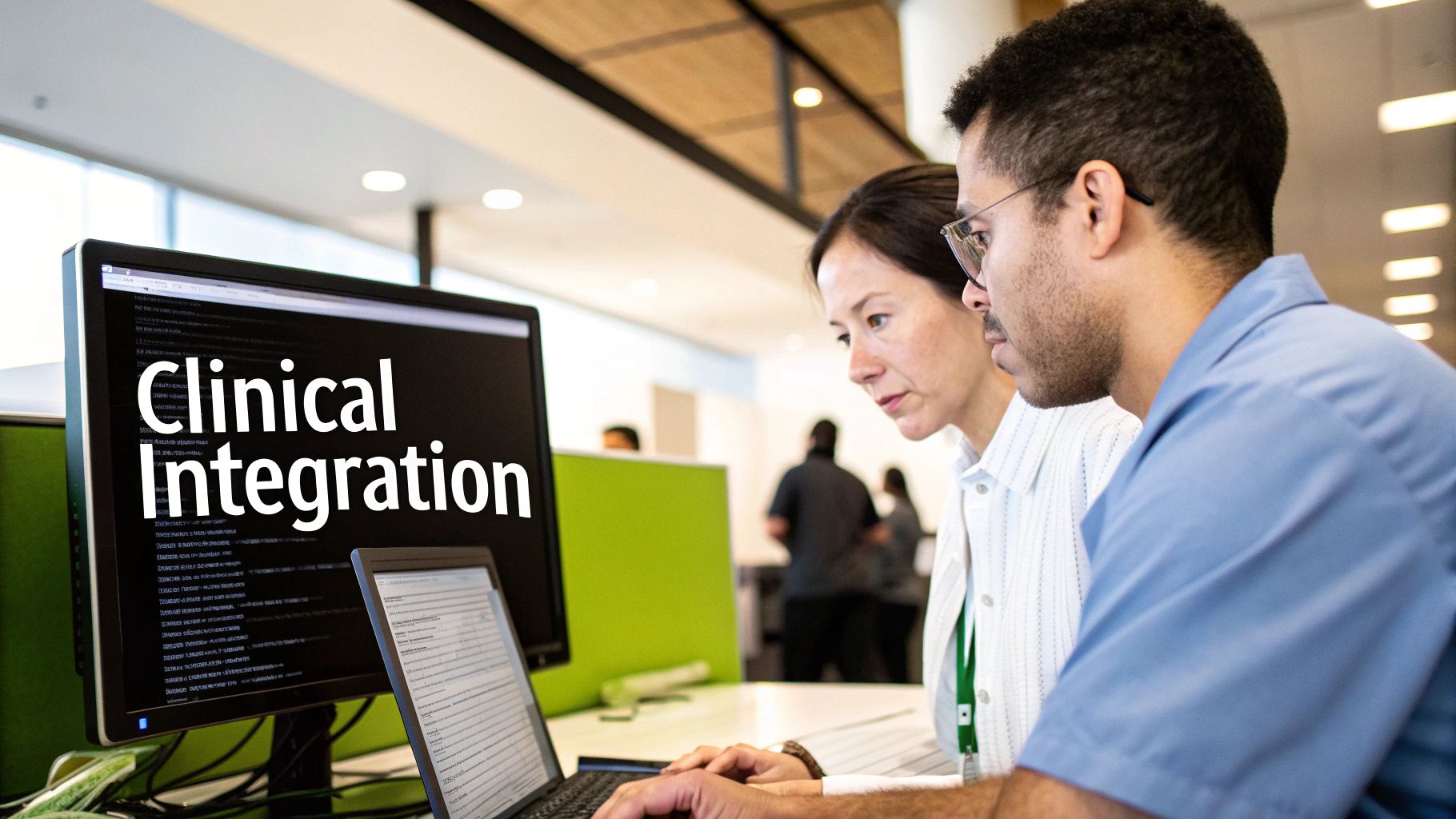
The future of diagnostics that everyone gets so excited about at a medical imaging SPIE conference isn't some far-off dream. It's closer than you might think. The research and concepts shared at these events are more than just academic exercises—they're the very blueprints for the next wave of clinical tools that can be built and put into practice right now.
The real challenge isn't the idea itself; it's bridging the gap between a brilliant concept and its seamless integration into a busy, real-world medical environment. This is where inspiration truly becomes reality.
At PYCAD, we live in that space between the visionary and the functional. Our entire mission is built around turning forward-thinking ideas from the medical imaging world into powerful, intuitive clinical instruments.
From Vision to a Powerful Clinical Tool
We believe that every healthcare provider, regardless of their setting, deserves access to the best technology possible. Our specialty is taking the complex, often daunting requirements of modern medical imaging and making them simple, accessible, and incredibly effective.
The true value of an innovation isn't just its technical brilliance, but how seamlessly it empowers clinicians to make better, faster decisions for their patients.
That’s why we at PYCAD, build custom web DICOM viewers and integrate them into medical imaging web platforms. Our focus is on creating systems that don't just add another layer of complexity but actually empower healthcare professionals to fully embrace AI-assisted diagnostics and a more streamlined image review process.
If you’ve left SPIE feeling inspired by the possibilities for smarter, more efficient medical imaging, we are the partner who can help you build it. We thrive on taking the incredible ideas from the medical imaging SPIE community and engineering them into the practical software that clinicians rely on every single day.
Let us help you transform that vision into a formidable clinical tool that makes a genuine difference.
To see how we bring these innovations to life, take a look at our portfolio and start your own journey toward building the future of medical diagnostics.
Your Questions About SPIE Medical Imaging, Answered
Jumping into a major scientific symposium for the first time can feel a little overwhelming. You've probably got questions, and that's exactly why we put together this section—to give you clear, straightforward answers about the SPIE Medical Imaging event.
Who is this Symposium Really For?
Think of this event as the annual gathering for everyone who lives and breathes medical imaging. It's a vibrant crossroads where the brightest minds in the field come together to share, learn, and push the boundaries of what's possible.
You'll feel right at home if you are a:
- Researcher or scientist exploring the next frontier in imaging physics or technology.
- Medical physicist or engineer who is building the incredible hardware that captures these images.
- Computer scientist or software developer creating the brilliant algorithms and AI that interpret them.
- Clinician—like a radiologist or surgeon—who relies on this technology to save lives every single day.
- Graduate student ready to soak it all in and connect with the very people who wrote the textbooks.
Basically, if your work touches any part of the medical imaging ecosystem, from creation to clinical application, this is your community. You'll leave feeling inspired and connected.
Is This All Just Academic Theory?
Not at all. In fact, that's what makes this event so special. While everything you see is built on a foundation of solid science, the entire symposium is geared toward translational research. The real focus is on breakthroughs that are on the verge of clinical use or are already making a difference in hospitals and clinics.
The magic of SPIE Medical Imaging lies in its unique blend of pure discovery and practical, real-world application. With so many industry leaders in the room, the conversations always circle back to one thing: creating solutions that genuinely improve patient outcomes.
How Can My Company Make an Impact Here?
There are some fantastic ways for companies to get involved and really connect with this dedicated audience. Setting up a booth in the exhibition hall is a classic for a reason—it puts your products and innovations directly in front of the decision-makers and brilliant minds you want to reach.
You could also sponsor a specific session or event to boost your company's profile. Even better, encourage your own R&D teams to submit their work and present. It’s an incredible way to share your own breakthroughs, scout for new talent, and spark the kinds of conversations that lead to powerful, game-changing partnerships.
Here at PYCAD, we live for turning the visionary ideas seen at events like SPIE into tangible, clinical tools. At PYCAD, we build custom web DICOM viewers and integrate them into medical imaging web platforms, giving healthcare providers the intuitive systems they need. To see what we can do, take a look at our portfolio.
